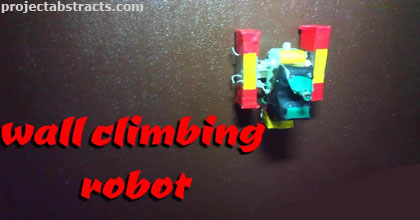This project is to build a wall climbing robot. This robot is a suction type of wall climbing robot; using PIC to do the interfacing, control the movement of the robot, ventilation fan and the sensors. The position sensors are used to sense any things blocking its path while it is climbing up, therefore it can be rotated left, right, up and down.
The on-board pump has been replaced by computer fan which will lower the cost as well as the weight of the original product. The cost of building this robot must be cheaper than the commercial robots.
BACKGROUND:
In all suction adhesion robot that are used for wall climbing robot, they used onboard pump that created a pressure drop inside the vacuum cups that are pressed against the wall or ceiling. As the vacuum cup are pressed against the wall, the on board pump will start to pump the air in the vacuum cup out to the surrounding. After so time, the pressure inside the vacuum cup is lower than that outside the vacuum cup thus it is able to “stick” onto the wall.

Wall Climbing Robot
This type of wall climbing robots require a smooth and flat vertical surface, therefore if there is a crack in the wall or the vertical surface is uneven, it will not work. Another problem of this type of robot is that it is much slower than other type of walk climbing robot. As it need time to build up the require pressure to hold itself on to the wall.
The suction adhesion robots are normally used on valley bridges and the temperature could be around 0 to 50 degree Celsius. As for the weight of this type of robot should not be more than 35 kg, thus the body of this robot should be make of non metallic material. The center of gravity of the robot must be kept as close as to the vertical surface as possible, as the force required to hold the whole weight of the robot will be reduced.
Although this kind of robot are normally used to do the cleaning for high buildings and under the high way bridges. This will in turn replaced human beings thus reducing the accident rate. This will farther increase the human being rate of living.
Source: University of Southern Queensland
Authors: Kang Boon Geh
Other Wall Climbing Robot Project Downloads
>> More information on Wall Climbing Robots